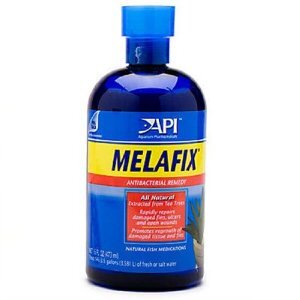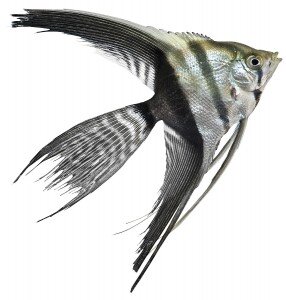The long angelfish fins and tails often need special care and attention as they can easily become damage and infected. This is especially true of veil angelfish with their exceptionally long fins and tails who are more susceptible to tail and fin rot, caused by bacteria, or a fungal infection.
Nipped Fins and Damaged Fins
Introducing the wrong tank mates, such as tiger barbs that are known to be fin nipping fish, to a freshwater angelfish tank can cause angelfish to get nipped fins. Angelfish can also be nippers and cause damage to other fish. If the fins are the only injury, the fins will grow back. However, you do need to address the cause, which is stress in the tank. If possible, remove the fish doing the nipping and put them in tank where they don’t cause trouble. It’s better not to move the victim as it doesn’t need additional stress.
If you damage to the angelfish fins and tail is a result of the tail or fins dragging along the substrate or scraping along décor, then you need a bigger tank for your fish. Also inspect the aquarium décor and remove any with exceptionally rough surfaces.
Prevent Fish Fin Diseases
Those nipped fins are now open to infection. To support the re-growth of the fins without further complications, do a partial water changes as you would for any diseases in fish. This helps keep the fins from becoming infected with a fungus or tail and fin rot. Change the water weekly or even twice a week for a couple of weeks. Tanks with good water quality have better success when treating injuries and diseases.
Raise the tank temperature to about 80 degrees. This also helps prevent your angelfish from contacting further infection.
Adding aquarium salt to the tank may also help prevent infection. Check the container for recommendations for the amount to add to the tank as a general preventative.
Stress Coat is a commercial product that contains aloe vera to relieve stress and promote the fishes natural slime coating. It helps heal damaged tissue and prevent infection.
How to Identify the Cause of Fin and Tail Rot
If the tail or fin starts to look rotted, dark red in color, jagged and uneven, or has a white growth, then an infection has set in. Identifying the cause will help you treat it. Bacterial infections will look more rough and dark in color. Fungal infections will have a white growth.
Treatment of Angelfish Fin Rot and Fungal Infections
If the infection looks minor, water changes may still be all you need for treatment. However, if the infection gets worse, you will need to treat it more aggressively to save the fish.
If you need to treat, the best option is to move the angelfish to a hospital tank if possible for treatment. Before treating tail and fin rot or a fungal infection in a community tank, do a 50 percent water change. Remove charcoal from the filter as charcoal will remove the medication from the water. Treatment is similar to any bacterial or fungal infection. Malachite Green, Methylene Blue, Maracyn, Maracyn II, and Waterlife- Myxazin, are commercial medications that treat fin and tail rot and other fungus infections.
 Some medications can destroy bacteria helpful in maintaining a healthy nitrogen cycle. MelaFix and PimaFix are two remedies that claim not to disturb the biological filtration system or change water quality.
Some medications can destroy bacteria helpful in maintaining a healthy nitrogen cycle. MelaFix and PimaFix are two remedies that claim not to disturb the biological filtration system or change water quality.
Nipped fins aren’t necessarily fatal. If the attacker is prevented from causing more damage, the fins will grow back. Problems occur if the damage is severe enough to cause body damage or a systemic infection. If you act quickly to do water changes and remove the bully fish, then your angelfish fins should return to their full glory. Click here for more on how to treat and prevent fin rot.


